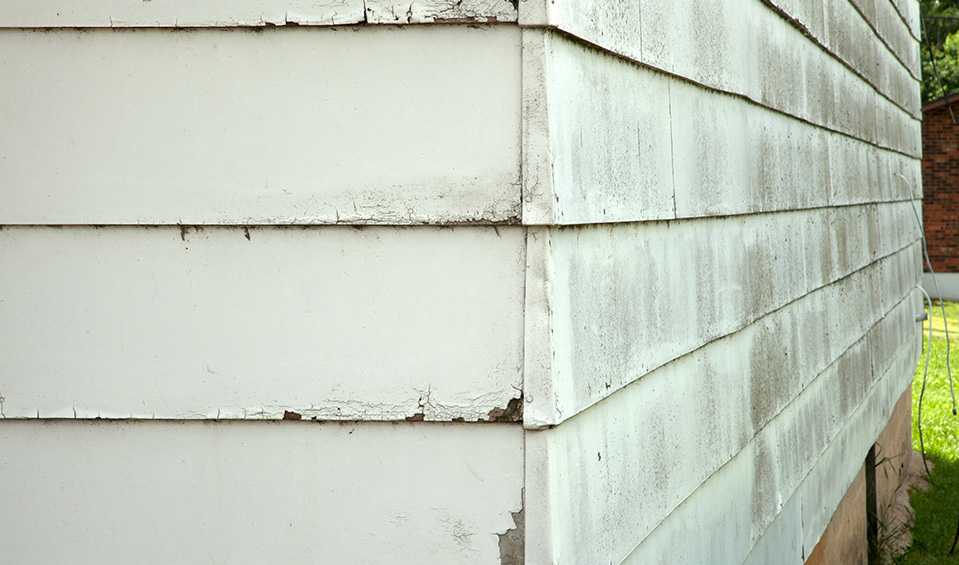
During the 1980s and early ‘90s, four million homes were clad in hardboard siding. It was an inexpensive and attractive enough option, and its popularity quickly grew.
But in 1996, after a month-long trial, the first of many courts ruled against a manufacturer of hardboard siding in a nationwide class action suit. Affordable? Certainly. But also defective. Popularity quickly dropped off. Today, hardboard is no longer sold as a siding option.
But what about the siding that didn’t get replaced after the revelations of the ‘90s? What is hardboard? How can you tell whether your old hardboard siding is causing problems? And (most importantly) what are possible solutions if it is?
What is hardboard?
Hardboard, also known as pressboard or the common manufacturer’s name, Masonite, is an engineered wood product made of wood fibers that have been compressed together. Although no longer manufactured for siding, it’s still used as an inexpensive material in building furniture, and as a temporary floor protector on construction sites.
Hardboard should not be confused with particle board. Although they are both manufactured from wood fibers, the process used to make them is not the same. Hardboard is made from wood chips, which are steamed, ground, and then treated at very high temperature and pressure. No additional binders are necessary when creating hardboard. Particleboard, by contrast, is made from sawdust that is combined with resins or other binders to hold it together before treating. Particle board is often used in subfloors and non-visible parts of cheaper furniture.
Despite the similarity in name, hardboard has nothing in common with Hardieplank siding, which is fiber cement siding made by James Hardie. It’s a manufactured siding option, but that’s where the similarities between the sidings end. James Hardie siding is made with cement and cellulose fibers, rendering it mostly immune to the damp and rot that plague wood-based siding options.
What’s the problem with hardboard siding?
In a perfect world, hardboard would have been a perfectly adequate siding material. In the real world, however, it was no match for the fact that all siding comes into contact with two dangerous elements: weather and people.
Weather: All hardboard siding naturally absorbs a certain amount of water due to exposure to the elements. This causes a bit of swelling. When perfectly installed and vigilantly maintained, this swelling doesn’t necessarily reach dangerous levels.
People: Unfortunately, perfect installation and vigilant maintenance require all of the people involved to be at the top of their game. Faulty installation (whether the result of contractors cutting corners or do-it-yourselfers making mistakes from lack of knowledge or experience) led to the host of problems that resulted in class action suits during the ‘90s. Swelling, rotting, buckling, and mildew required many homeowners to replace their siding only a short time after installation.
How can you tell if your old hardboard siding has a problem?
If you see any of these issues, your pressboard is past its prime:
Swelling. If your siding is clearly misshapen or warped at places, there is already a significant problem.
Discoloration. This is an indication that moisture is regularly settling in a particular area. Some discoloration can also be caused by mold.
Nails rusting or popping out. This means that your siding has been shifting and expanding or admitting moisture.
Infestation. Termites feasting on your siding won’t stop there, and the damage they cause opens the way to wider problems.
What can you do about damaged hardboard siding?
If the problems are very minor, proper caulking, painting, and water management can keep the damage under control for some time. Keep an eye out for any trouble areas and deal with them as soon as issues appear.
If there seems to be significant damage or if you are unable to commit to frequent maintenance and repair tasks, your best option is replacement. New manufactured siding options like fiber cement don’t have the same susceptibility to damp conditions or pest infestation that older siding types do, and are safer in emergencies like storms or fires as well. Want to know more about your siding options and what replacing the siding on your home would entail? Tulsa Renew can help. Schedule your free, no-obligation consultation and quote today.
